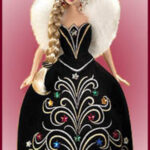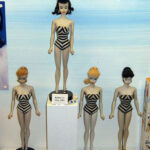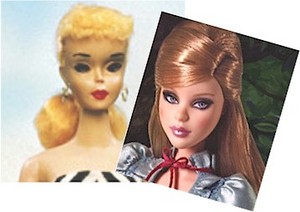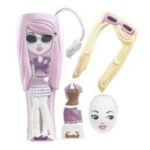Today’s children are playing with toys that came out when their grandparents were young and these toys have not changed much over the years as their initial introduction into society was done so well.
Top Ten Toys of Yesterday: 1960s:
1. Hot Wheels
Husband of famed Barbie creator, Elliot Handler invented Hot Wheels while experimenting with adding axles and free-rolling wheels in 1968. His first car reached three hundred miles an hour. The first year sold ten times more than expected, making the new toy a hit.
The reason for Hot Wheels’ instant success was its revolutionary features which allowed the cars to roll further and the orange plastic track allowed the cars to perform tricks, such as jumps and loops. Hot Wheels are powered by gravity, but their design maximizes gravity’s influence. These features are what keeps Hot Wheels a favorite even today.
The famous Hot Wheels logo was created by artist Rick Irons who worked for Mattel at that time.
2. LEGO
All the parents who continually step on little plastic LEGO pieces throughout their homes can thank Denmark for their pain.
LEGOS were strictly a Danish toy until 1962, when they were first introduced in the United States. By 1966, LEGOS was an established favorite toy in this Country and still is today.
The toy’s history begins in 1932 when a master carpenter in Billund, Denmark sets up a business to manufacture ladders, ironing boards and wooden toys. Ole Kirk Christiansen names his company LEGO from the letters in the Danish word for ‘play well’ (leggodt).
The LEGO was the first company in that Country to purchase a machine for making plastic molded toys. In 1949, two years later, LEGO produced the forerunner of today’s LEGOS, Automatic Binding Bricks. Six years later, in 1955, LEGO launched it’s LEGO System of Play with twenty-eight sets and eight vehicles. After a few more years of developing this toy, the company obtains a patent for its newly invented stud-and-tube connecting system.
When the LEGO System of Play was introduced in the United States in 1962, it was initially offered as a loose set of bricks. The line has continued to grow in this Country and some of their specialty kits, such as the Star Wars themed kits, sell out year after year.
3. G.I. Joe
The story behind the creation of G.I. Joe, the toy, is a bit murky. Different stories are floating around, but the gist of it is that the real story is a little piece of each.
Stanley Weston approached Hasbro about creating a male doll based upon his television show The Lieutenant.Hasbro’screative director rejected the television tie-in, but did go to executives about creating a soldier with movable parts. The term “figure” was used instead of doll as the day’s mindset did not allow for boys playing with dolls. The resulting toy was named after the lead character in a movie instead of the television series.
During World War II, David Breger was contracted to produce a comic strip for the United States Military YANK Magazine and Stars and Stripes Newspaper. Breger named his comic strip character, G. I. Joe. That comic strip character became a movie star when United Artists released the movie: The Story of G.I. Joe in 1945.
The G.I. Joe figure was designed by Walter Hansen and Phil Kraczkowski and was sold in 1964 wearing uniforms of all four branches of the United States Military. To differentiate from dolls, these “action” figures were movable in twenty-one places and had a scar on its face. Incidentally, a manufacturing defect created one thumbnail on the wrong side of the thumb which was later used to protect its copyright.
G.I. Joe coined the term “action figure.”
From 1964 to 1968, the four G.I. Joe action figures were named: “Rocky,” the marine and soldier; “Skip,” the sailor; and “Ace,” the pilot. Beginning in 1966, soldiers from other Countries first appeared in the toy line.
4. Easy Bake Oven
America’s first working toy oven was introduced by Kenner Products, now a division of Hasbro, in 1963. In that first year, over half a million ovens were sold for $15.95.
The first Easy Bake Oven was turquoise and had a fake stove top. The oven was heated by a lightbulb. The toy was such a huge hit that five years later, General Mills began making miniature boxes of its Betty Crocker line for children to use in the Easy Bake Ovens.
Today’s Easy Bake Oven comes with Dual-Temps, allowing children to bake on high and low settings.
5. Etch-a-Sketch
The first time Ohio Art saw the toy inventor Arthur Granjean created was at the 1959 International Toy Fair in Nuremburg, Germany. The Magic Screen, L’Ecran Magigue, did not interest them. It was not until they happened upon the toy a second time that they decided to give it a try.
Ohio Art began production on July 12, 1960 and because of the enormous response, decided to keep their plant open until noon on Christmas 1960 in order to be able to ship them immediately to the West Coast for people in California to be able to buy them Christmas Eve, in time for their Christmas morning.
Very little has changed over the years, and yet the Etch-a-Sketch is still the number one drawing toy of all time.
6. Super Ball
One thing I remember from my own childhood was begging for a Super Ball. These cool balls could bounce over buildings and they were so much fun bouncing over other people’s houses.
When Wham-O released the Super Ball for sale the summer of 1965, they quickly became the most popular toy of the year and by Christmas, over seven million Super Balls had been sold at only ninety-eight cents each.
The ability to leap over a three-story building is what gave the ball its name. Super Balls had so much “bounce” that when simply dropped, they would jump almost back to the same level dropped from.
That bounce came from compressing a synthetic rubber under three thousand, five hundred pounds of pressure per square inch. Chemist Norman Stingley experimented during his spare time to come up with this unequaled resilience.
Although initially, the first rubber material did not stay together, Wham-O kept working until they came up with a compound that would hold up under normal use.
As I think about today’s less Super Super Balls, I can still hear the commercials from the sixties and seventies bouncing around in my head.
7. The Game of Life
As far fetched as the story behind this game is, it really did come about as a result of President Lincoln deciding to grow a beard.
Lithographer, Milton Bradley’s claim to fame was a portrait of Abraham Lincoln which he sold as part of his business. When the President decided to grow a beard, sales for Bradley’s lithograph plummeted. The only thing Bradley had available to save his business was to begin printing copies of a game he had designed. The Checkered Game of Life put Milton Bradley into the game business with over forty-five thousand copies sold by the end of the year.
Fast forward one hundred years to the company’s one hundredth anniversary.
Milton Bradley executives contracted game inventor, Reuben Klamer to design a game to celebrate their one hundredth anniversary. Klamer was inspired by the game that began the company and collaborated with another inventor to develop The Game of Life which was released in 1960 to celebrate the one hundredth year anniversary of Milton Bradley.
Today’s The Game of Life has been updated to include rewards for things like recycling and learning CPR and comes in twenty different languages.
8. Sea Monkeys
Although shown in advertisements as somewhat human in appearance, Sea Monkeys are actually a relative to bryn shrimp. Artema nyos, the creature’s actual name, enter cryptobiosis, a natural form of suspended animation when removed from water. Upon being placed back into water, they leave the state of cryptobiosis. In order to live and breed, they need salt water.
Harold von Braunhut noticed this creature and its peculiar behavior when removed from water and came up with the brilliant idea of marketing them as pets. He initially advertised them as Instant Life in comic books everywhere for only forty-nine cents by mail order.
In May of 1962, he changed the name to Sea Monkeys, but it was not until recently that people could purchase Sea Monkey kits in stores across the Country.
I remember seeing them in gumball machines outside of stores when I was younger, and during this research I learned that during the 70s and 80s they were sold in packets for twenty-five cents through gumball machines at A&P; Grocery Stores.
Beginning in 2005, slot machines were released with a Sea Monkey theme. It seems these creatures will continue to be with us.
9. Barrel of Monkeys
When Lakeside Toys first introduced Barrel of Monkeys in 1966, they found that two of the names they wanted to use were already taken (Barrel of Fun and Barrel-O-Fun). After debating on the name, they decided to change the S-shaped hooks into monkeys with S-shaped arms and name the game after a well known phrase “More fun than a barrel of monkeys.
After two years, Lakeside Toys changed the cardboard tube into a two-piece plastic barrel. The original version came with twelve plastic monkeys in three colors – red, blue and yellow.
Today, Milton Bradley owns the game and offers the barrels in blue, yellow, red or green with monkeys in the same color.
10. Operation
The game Operation is the result of a 1962 college class project. University of Illinois industrial design student, John Spinello earned the highest grade in his class with his electric toy in a box. Spinello’s toy was metal with holes and lines drilled through the top. It came with a metal rod with which players would attempt to put the rod between the openings without touching the sides. Whenever the rod touched the sides, a bell would sound off due to the circuit he created by charging metal plates.
Spinello sold the game to his godfather’s employer, Marvin Glass of Marvin Glass Associates for five hundred dollars and a job. The game made its way to Milton Bradley, where they redesigned it into the game Operation.
Milton Bradley kept the structural core, changed the bell to a buzzer and a light and the metal rod to a pair of tweezers. The holes were filled with plastic pieces to give players something to reach in and pull out without touching the sides.
Today’s Cavity Sam, the guy on the OR table in Operation, has a new ailment – brain freeze. Otherwise, the game has changed little over the years.





